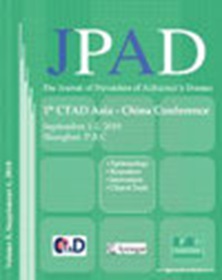1990~2019年中国阿尔茨海默病和痴呆的疾病负担及归因危险因素
IF 7.8
3区 医学
Q1 CLINICAL NEUROLOGY
引用次数: 7
摘要
背景关于阿尔茨海默病和其他形式痴呆负担的最新信息对循证医疗保健规划非常重要。然而,在国家和省级层面上,中国人口都缺乏这样的估计。目的估计中国阿尔茨海默病和其他形式痴呆的某些危险因素的时间趋势和可归因负担。设计、设置和参与者这是对2019年全球疾病负担研究(GBD 2019)的观察性描述。阿尔茨海默病和其他形式痴呆症的发病率、死亡率、患病率、残疾调整生命年(DALYs)、残疾生活年(YLDs)和生命损失年(YLLs)的数据来自中国国家和省级GBD 2019研究。测量使用了六个指标:发病率、死亡率、患病率、DALYs、YLLs和YLDs。按年龄、性别、地区和年龄标准化率(95%的不确定性区间)详细计算绝对数。结果1990年至2019年,死亡人数(247.9%)、发病率(264.8%)、患病率(296.5%)、DALY(228.1%)、YLD(308.7%)和YLLs(201.7%)分别呈显著上升趋势。相应的年龄标准化率分别提高了6.2%、19.3%、33.6%、10.7%、33.4%和3.1%。吸烟、高体重指数、高空腹血糖水平和代谢风险是四个主要风险因素。在较发达地区,女性的负担高于男性。结论我国疾病负担显著增加。疾病负担的区域差异伴随着经济水平和地理位置的差异,以及风险因素暴露水平的不同。迫切需要有针对性的预防和控制策略来减轻疾病负担。本文章由计算机程序翻译,如有差异,请以英文原文为准。
Disease Burden and Attributable Risk Factors of Alzheimer’s Disease and Dementia in China from 1990 to 2019
Background Updated information on the burden of Alzheimer’s disease and other forms of dementia are of great importance for evidence-based health care planning. However, such an estimate has been lacking in Chinese populations at both national and provincial levels. Objective To estimate the temporal trends and the attributable burdens of selected risk factors of Alzheimer’s disease and other forms of dementia in China. Design, Setting, and Participants This is an observational description of the Global Burden of Diseases Study 2019 (GBD 2019). Data on incidence, mortality, prevalence, disability-adjusted life years (DALYs), years lived with disability (YLDs), and years of life lost (YLLs) of Alzheimer’s disease and other forms of dementia were derived from the GBD 2019 study at both national and provincial levels in China. Measurements Six indicators were used: incidence, mortality, prevalence, DALYs, YLLs, and YLDs. Absolute numbers in detail by age, sex, region, and age-standardized rates (with 95% uncertainty intervals) were calculated. Results There were notable increasing trends in the number of deaths (247.9%), incidence (264.8%), prevalence (296.5%), DALYs (228.1%), YLDs (308.7%) and YLLs (201.7%) from 1990 to 2019, respectively. The corresponding age-standardized rates increased by 6.2%, 19.3%, 33.6%, 10.7%, 33.4% and 3.1%. Smoking, high body mass index, high fasting plasma glucose levels, and metabolic risks were the four leading risk factors. Higher burden was observed among females versus males and in the more developed regions. Conclusions The disease burden in China were increasing substantially. Regional differences of the disease burden are accompanied by discrepancies of economic level and geographical location, as well as different levels of exposure to risk factors. Targeted prevention and control strategies are urgently needed to reduce the disease burden.
求助全文
通过发布文献求助,成功后即可免费获取论文全文。
去求助
来源期刊

Jpad-Journal of Prevention of Alzheimers Disease
CLINICAL NEUROLOGY-
自引率
7.80%
发文量
85
期刊介绍:
The JPAD « Journal of Prevention of Alzheimer’Disease » will publish reviews, original research articles and short reports to improve our knowledge in the field of Alzheimer prevention including : neurosciences, biomarkers, imaging, epidemiology, public health, physical cognitive exercise, nutrition, risk and protective factors, drug development, trials design, and heath economic outcomes.
JPAD will publish also the meeting abstracts from Clinical Trial on Alzheimer Disease (CTAD) and will be distributed both in paper and online version worldwide.
 求助内容:
求助内容: 应助结果提醒方式:
应助结果提醒方式:


